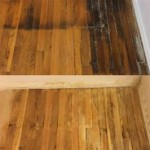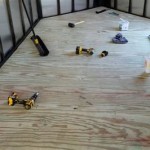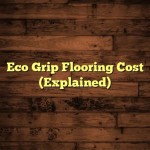Vinyl Strip Flooring: An Ideal Choice for HDB Homes
Vinyl strip flooring has emerged as a popular choice for homeowners in Singapore, particularly those residing in Housing and Development Board (HDB) flats. This flooring option offers a compelling combination of aesthetic appeal, durability, and practicality, making it a suitable and often budget-friendly alternative to traditional materials like wood, tile, or marble. The following article will explore the advantages of vinyl strip flooring for HDB applications, detailing installation considerations, maintenance requirements, and various design possibilities.
Vinyl strip flooring, also known as luxury vinyl plank (LVP), comprises individual planks that closely mimic the appearance of natural wood. These planks are typically constructed from multiple layers, including a protective wear layer, a decorative print layer, a core layer for stability, and a backing layer for cushioning and sound insulation. The thickness and composition of these layers significantly contribute to the overall performance and longevity of the flooring.
Advantages of Vinyl Strip Flooring in HDB Flats
Several key advantages make vinyl strip flooring a particularly attractive option for HDB flats. These benefits extend beyond mere aesthetics and encompass practical considerations crucial for comfortable and cost-effective living.
Water Resistance: One of the most significant advantages of vinyl strip flooring is its exceptional water resistance. Unlike natural wood, which can warp or rot when exposed to moisture, vinyl is inherently waterproof. This makes it an ideal choice for areas prone to spills and humidity, such as kitchens, bathrooms, and service yards commonly found in HDB flats. The water-resistant nature also reduces the risk of mold and mildew growth, contributing to a healthier living environment.
Durability and Longevity: Vinyl strip flooring is highly durable and can withstand heavy foot traffic, making it suitable for the bustling environment of a family home. The wear layer, typically made of a clear, protective coating, resists scratches, stains, and dents, ensuring that the flooring maintains its appearance for many years. This durability translates to long-term cost savings, as the need for frequent replacements is minimized. The wear layer thickness is a crucial factor influencing the flooring's ability to resist wear and tear. Higher wear layer thicknesses (measured in mils) offer greater protection and are recommended for high-traffic areas.
Comfort and Sound Insulation: The layered construction of vinyl strip flooring provides a comfortable underfoot feel and offers superior sound insulation compared to harder flooring options like tile or concrete. The cushioning effect reduces fatigue when standing for extended periods, while the sound-absorbing properties minimize noise transmission between floors, contributing to a more peaceful living environment. This is particularly beneficial in HDB flats where minimizing noise pollution is often a concern.
Installation Considerations for HDB Flats
The installation process of vinyl strip flooring is generally straightforward, which often leads to reduced labor costs. However, careful preparation and attention to detail are crucial for achieving a professional and long-lasting result. Several installation methods are commonly employed, each with its own advantages and disadvantages.
Click-Lock Installation: The click-lock system is a popular choice for DIY enthusiasts and professional installers alike. This method involves interlocking the planks together using a tongue-and-groove mechanism, creating a seamless and floating floor. No glue or adhesive is required, making the installation process relatively quick and clean. The floating nature of the floor allows for slight expansion and contraction due to temperature and humidity changes, minimizing the risk of buckling or warping. This is particularly relevant in Singapore's humid climate.
Glue-Down Installation: The glue-down method involves adhering the vinyl strips directly to the subfloor using a specialized adhesive. This method provides a more secure and stable installation, making it suitable for areas with heavy foot traffic or where rolling loads are anticipated. The glue-down method also offers better resistance to moisture penetration and is often preferred for bathrooms and kitchens. However, this method requires a perfectly smooth and level subfloor, as any imperfections will be visible through the vinyl. Proper adhesion is crucial, and professional installation is often recommended to ensure optimal results.
Subfloor Preparation: Regardless of the chosen installation method, proper subfloor preparation is essential for a successful installation. The subfloor must be clean, dry, level, and free from any debris or imperfections. Any existing flooring, such as old tiles or carpet, should be removed. Cracks and holes in the subfloor should be filled and leveled using a suitable patching compound. A self-leveling compound may be required to create a perfectly smooth surface, especially for glue-down installations. The type of subfloor (e.g., concrete, plywood) may also influence the choice of adhesive and installation method.
Maintenance and Care for Vinyl Strip Flooring
Maintaining vinyl strip flooring is relatively simple and requires minimal effort. Regular cleaning and preventative measures can help extend the life of the flooring and maintain its appearance for years to come.
Regular Cleaning: Routine cleaning should involve sweeping or vacuuming to remove loose dirt and debris. For deeper cleaning, a damp mop with a mild detergent is sufficient. Avoid using harsh chemicals, abrasive cleaners, or scouring pads, as these can damage the wear layer and dull the finish. It is crucial to follow the manufacturer's recommendations for specific cleaning products and procedures.
Preventative Measures: Placing mats at entrances can help trap dirt and debris, preventing them from being tracked onto the flooring. Using furniture pads under heavy furniture can protect the flooring from scratches and dents. Avoid dragging heavy objects across the floor. Promptly clean up any spills to prevent staining. Maintaining a consistent indoor temperature and humidity level can also help prevent warping or buckling.
Repairing Damage: Minor scratches and scuffs can often be repaired with specialized vinyl repair kits. For more significant damage, such as gouges or tears, it may be necessary to replace the affected plank. This is one of the advantages of vinyl strip flooring, as individual planks can be replaced without having to replace the entire floor. Keep extra planks on hand for future repairs. For glue-down installations, professional assistance may be required for plank replacement.
Design Options and Aesthetic Versatility
Vinyl strip flooring offers a wide range of design options and aesthetic versatility, allowing homeowners to create the desired look and feel for their HDB flats. The advanced printing technology used in the manufacturing process allows for realistic replication of various wood species, textures, and colors.
Wood-Look Options: Vinyl strip flooring can mimic a variety of wood species, including oak, maple, walnut, and cherry. The planks can be embossed with realistic wood grain patterns, creating a natural and authentic appearance. Different plank sizes and widths are also available, allowing for customized designs. Wider planks can create a more spacious and contemporary look, while narrower planks can evoke a more traditional and rustic feel. The color palette ranges from light and airy to dark and dramatic, allowing homeowners to match the flooring to their existing décor.
Pattern Variations: Beyond the wood-look, vinyl strip flooring can also mimic other materials, such as stone and tile. This provides even greater design flexibility and allows homeowners to create unique and visually appealing spaces. Different installation patterns, such as herringbone, brick, or staggered patterns, can also be used to add visual interest. The ability to mix and match different colors and textures allows for even greater customization.
Matching with Décor: Vinyl strip flooring can be easily integrated with various décor styles, from modern and minimalist to traditional and eclectic. The versatility of the material makes it a suitable choice for any room in the HDB flat. In living rooms and bedrooms, warm wood tones can create a cozy and inviting atmosphere. In kitchens and bathrooms, lighter colors and water-resistant properties make vinyl strip flooring a practical and stylish choice.
In conclusion, vinyl strip flooring presents a compelling flooring solution for HDB homes, offering a balance of aesthetics, durability, and practicality. The water resistance, ease of maintenance, and wide range of design options make it a valuable and cost-effective choice for homeowners seeking to enhance the comfort and style of their living spaces. Careful consideration of installation methods and subfloor preparation will ensure a long-lasting and visually appealing result.

Hdb Material Technology

Beginner S Guide To Maintaining Hdb Vinyl Flooring Floorrich

Hdb Material Technology

Hdb Mnh A Guide To The Features Of Your New Bto Flat

How To Choose The Right Vinyl Flooring For Hdb Laminate Sg

Hdb Flooring Vinyl Vs Tile Laminate Parquet Vsscreed

Hdb Floor Finishes

Hdb Flooring Vinyl Vs Tile Laminate Parquet Vsscreed

Hdb Floor Finishes

Diy Vinyl Flooring For Your Home In Singapore
Related Posts








